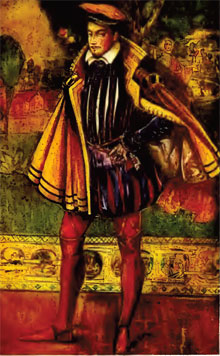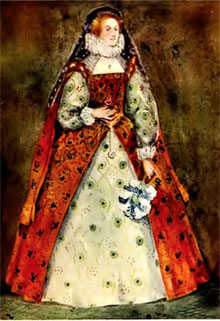Elizabethan Clothing
The Elizabethan costume is maybe the best known of all Renaissance clothing. It was made famous by the great Queen herself and by the plays of the immortal Shakespeare. The period was the era of the enormous ruff and the jeweled stomacher.
Men’s clothing
The doublet, a garment of Italian fashion, was close fitting, with the sleeves tied by means of points (ribbons with metal tags). These doublets were carried down to a long peak in front, into the form known as peascod belly.
The jerkin was a jacket with sleeves, and was often worn over the doublet. The sleeves of the jerkin could be open from shoulder to wrist to show the doublet sleeve underneath, were wide and ornamented with large buttons. The jornet was a loose travelling cloak, and the jumper was a loose jerkin, worn for comfort or extra clothing in winter.
Typical for the Elizabethan clothing were the very wide breeches (trunks), worn by nearly everybody in the early part of the Reign. They were made of a series of wide bands, sometimes of different, alternating colors, and stuffed with wool or rags. The bombasted hose was so large that special seats were ordered in the Houses of Parliament for the gentlemen who wore them.

Elizabethan Men's Costume
Later, the fashion conscious began to wear the Renaissance Venetian breeches, which were very full at the top and narrowed to the knee. They were slashed and puffed, or paned like lattice windows with bars of colored stuffs or gold lace. The Elizabethan fashion adopted also the French breeches, tight and ruffled in puffs about the thighs.
Men wore little cloaks covered with embroidery, lace, or with pearls. For winter or hard travelling the jornet or loose cloak was worn. The older wore long gowns with hanging sleeves, made to fit at the waist and over the trunks.
The Elizabethan hats varied in shape from steeple crowned, narrow-brimmed, to flat, or broad crowned. Some of them had already a tendency towards the broad-brimmed Jacobean hat. The hatbands were gold chains, ruffled lace, silk or wool.
The stockings were of yarn, silk, or wool. They were gartered about the knee, and pulled up over the breeches. Some men wore no garters, relying only on the shape of their legs. The shoes were shaped to the foot, and made of various leathers or stuffs, sometimes decorated with a rose of ribbon. There were also the shoes with high cork soles called moyles.
Women’s Elizabethan fashion
The women’s Elizabethan costume was characterized by the ruff and the large hoop (farthingale).
In the early years of Queen Elizabeth’s reign, the simpler clothing of the previous period was still in fashion. The ruff was fairly small and stiff. It was before the advent of the heavily-jeweled and embroidered stomacher, and the enormous spread of skirt, and the dress was just a modification of that worn by the ladies in the time of Henry VIII.
Dutch ladies at Elizabeth’s court brought the art of starching the fine cloth of cambric (or batiste in French), originating from Cambrai. This influenced clothing through various ways of folding, cutting, and pinching the ruffs. The starching allowed a circular ruff of cambric to stand by itself. The ruff could also be made from lace or linen. It was small or large, with the most fashion oriented wearing such a size that it required a wired under-proper.
Elizabethan gownsThe Elizabethan gown was cut square across the bosom and low over the shoulders. The sleeves were ending in bands of cambric over the hands, and were slit to show puffs of the same material from the elbow to the wrist. The skirt was without any train. Over this was worn a second gown, generally of plain material, split above in a V-shape, and below at the waist, and cut away to show the under gown. The sleeves of this gown were wide, and were turned back or cut away just by the elbow. Both gowns were laced up the back. The second gown had a high, standing collar, lined with rich silk or with lace, which later evolved in an exaggerated form.
The Elizabethan costume included a jerkin similar to that worn by men, except that often it was cut low and square over the bosom, and was not stuffed so much in front. The materials used were rich, and the sleeves were split and tied with ribbons. The false sleeves were attached at the shoulders, and left to hang loose, puffed, slashed all over, with or without bands of cambric or lace at the wrists.

Elizabethan Women's Costume
The jerkin was sometimes worn buttoned up like a man's, to the neck. When the hoops came into fashion and were worn high up near the waist, the basque or flounce at the bottom of the jerkin was made long, and pleated full to the top of the hooped petticoat.
The more conservative Elizabethan clothing required a gown buttoned high up to the ruff and opened from the waist to the feet to show a full petticoat of rich material.
Women’s cape was worn over the head and shoulders. The ladies wore the shaped cape, with the high collar that the men wore as well. The French hood with a short liripipe was worn by country ladies, covering the hair, and showing nothing but a neat parting in front.
The hair can be dressed with pearls, rings of gold, strings of pearls, feathers, or glass ornaments. Men and women wore earrings, the fashion being more common to men than women. Hats were interchangeable, especially the trim hat with a feather, similar with those worn by the Yeoman of the Tower of London, but smaller.
The wing sleeves, open from the shoulder all the way down, were so long sometimes as to reach the ground, and were left hanging in front, or thrown back over the shoulders, to better display the rich under-sleeve.
The Elizabethan reign was the time of women’s painted faces. In the streets or in the theatres, ladies could also wear velvet masks.
The shoes had cork soles, were high-heeled, and round-toed. Their heights could range from two to seven or eight inches, and they were called chopines. Their purpose was to protect the wearer from the filth of the streets. There is a mention of these models in Hamlet, telling us that the richly-embroidered shoes were placed into them when one went outdoors. The shoes were made of leather and velvet stitched with silk, embroidered with gold, and sometimes laced with colored silk laces.
There were regulations governing the clothing colors and materials used during the Elizabethan era. No person except royalty might wear crimson except in under-garments, and the middle class were not allowed to wear velvet except for sleeves.
Women’s Renaissance clothing in the times of Henry VIII.
Men’s Renaissance clothing during the reign of Henry VIII.
Men’s and women's clothing during the reigns of Edward and Mary.
Renaissance clothing main page.